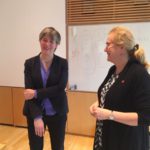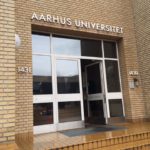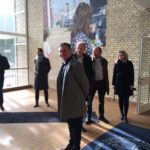The Management Council has just visited Aarhus University in Jutland, Denmark. Our colleagues in Aarhus had prepared a busy programme for us. To begin with, Pro-Rector Berit Eika presented the university and current developments in research policy.
- Pro-Rector Berit Eika and Vice-Chancellor Eva Åkesson.
- The Management Council looks around.
In the mid-2000s, the 20 universities in Denmark were merged to create eight larger universities. The university has campuses in Aarhus, Copenhagen and Herning, and research at another ten or so locations – including on Greenland. Aarhus University now has 39,000 students, 8,000 employees and a turnover of EUR 884 million. The city of Aarhus has 350,000 inhabitants. Both the city and the university are therefore somewhat larger than Uppsala.
Last year, the Danish government launched a new higher education policy, with a number of different reforms. The aim is to increase access to higher education throughout the country. They intend to do this by creating local ‘learning centres’. They also want to strengthen the link between education and the labour market and reduce the number of international students. In total, the number of places for international students in the country will be reduced by 1,000.
Like us, Aarhus University is in the midst of drawing up new strategies for the university. The focus areas are familiar from our discussions at home: internationalisation, collaboration and interdisciplinary cooperation. The strategies will be finalised this autumn, if all goes according to plan.
Uppsala and Aarhus are both members of several international university networks, including The Guild, Coimbra and the Southern African–Nordic Centre. We had an interesting discussion on how to best use the networks in which we cooperate.
After that, we were given a presentation of the Dual Careers project. The project aims to enable elite student athletes to combine sport and study, and entrepreneurs to combine entrepreneurship and study. This has required flexibility on the part of departments and the administration, more study guidance, mentors from within and outside the university, joint planning and follow-up. The hope is that some of the outcomes of the project may benefit more students.
Ten years ago, the eight universities in Denmark and the Danish Ministry of Education together established a Danish–Chinese education and research centre in China. The Executive Director of the Sino-Danish Centre, Morten Laugesen, described developments. With support from the Danish business sector, they were able to construct a building that now houses education and research facilities, but also provides 20 apartments for teachers and researchers. It is intended as an equal partnership, despite great differences, with 50/50 involvement of both parties. One consequence of this is that all projects involve both a researcher or teacher from China and one from Denmark. To date, about 1,000 students, 220 researchers and more than 160 doctoral students have participated in the Centre.
We were treated to a real Danish breakfast in the canteen at Kemikum – smörrebröd (open-faced sandwiches). After lunch there was time for the Vice-Chancellor to have one-on-one talks with the Rector of Aarhus University, while the rest of the delegation had a walk aorund the campus and the University Park.
The physical environment at Aarhus University is characterised by yellow brick, Danish architecture and design. They also have a large collection of modern art which is on view around the campus. We paid a visit to a brand new life sciences laboratory, the Skou Building, named after Professor Jens Christian Skou, who won the Nobel Prize for Chemistry in 1997.
The visit concluded with a presentation of Campus 2.0 and the university’s digitisation strategy. Particularly interesting for us, in view of our Uppsala University 2050 project and our work on University-wide IT. Aarhus University has agreed on principles for the development of the physical environment, for example, sustainability, strengthening the connection between education and research, and meeting places such as cafés and convenience stores. The plans for the conversion of the old hospital area are impressive and it will be interesting to follow their progress.
Many thanks to our colleagues in Aarhus for sharing your experiences so generously with us and for an inspiring day.



